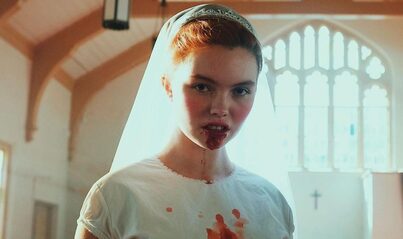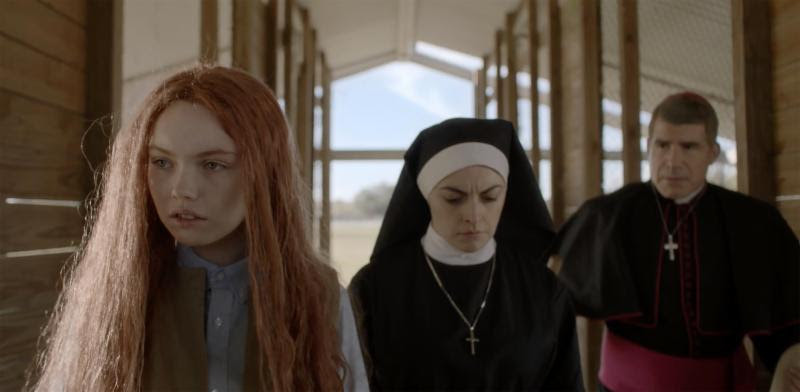 Actress Pollyanna McIntosh has arrived onto the scene with her debut film, Darlin’, and it’s an animal… …Written by McIntosh, Darlin’ is a direct sequel to the 2011 nasty horror flick, The Woman, based off of characters created by director Lucky McKee and author Jack Ketchum. The film follows a pair of feral cannibals in The Woman, with McIntosh returning to the role, and The Woman’s teenage daughter, Darlin’ (Lauryn Canny). For reasons unknown, The Woman leaves Darlin’ at the hospital, where she is cleaned up and eventually transferred to a home for girls run by the church. But as those at the church discover, what is wild cannot be tamed. I’m just going to say it right now: look out for actress Lauryn Canny. Darlin’ is a beast of a film, and Canny delivers a ferocious performance in the role of the title character. Canny already has a unique look to her, and channels a primal energy so superb, I can’t imagine anyone else playing Darlin’. Part savage beast and part charming young woman, Darlin’ is a fascinating character who keeps the audience and other cast members on edge. Canny makes the hairs stand up on the back of your neck with warning growls that sound completely inhuman, but at the same time, she lures us in with a deep-seeded sorrow and a yearning for forgiveness of the horrible things she’s done. Darlin’ is a fierce coming of age story that packs a violent punch, yet McIntosh gives us a “monster” we can root for. Darlin’ is interesting because it isn’t the horrifying, discomforting cannibal film that The Woman was. McIntosh is after some important messaging here, and one of those themes is that none of us are who we appear to be on the surface. Darlin’ is riddled with characters who are either misunderstood or misrepresent themselves, such as the sinister Bishop (Bryan Batt), or even Darlin’s momma, who just wants companionship and safety for her tribe. The people that are kind to Darlin’ receive kindness, and those that don’t, well, you can probably guess. The tragedy of this bloody drama is the realization that, while we can be who we want to be, we can’t escape our past. Darlin’ is plagued by the lives she’s taken and the human flesh she’s eaten, at one point saying “it feels like a sin to eat,” a sad piece of dialogue, because eating what she has, has always been about survival, nothing more. McIntosh brings a powerful female voice to Darlin’ with some burning commentary on religion and the false notion of the dominance of men. Under the Bishop’s care, we watch as Darlin’ is slowly transformed from a wild animal into what the Bishop prides as a sweet young princess, emphasized by slow, thoughtful camera movements which present Darlin’ in soft, angelic light, while keeping her mother in dark shadows, a stark contrast between the life she has and the one she had. All of the women at the church, from the fellow young girls to the Bishop’s right hand woman, Sister Jennifer (Nora-Jane Noone), serve under his rule, the way he likes it and the way the church seems to demand. One scene in particular involves Darlin’ being forced to learn to read a passage of the bible regarding Adam and Eve that says Eve would be punished with the pain of childbirth, her sole purpose, to which Darlin’ literally runs from the idea of living under man’s law. All of the women form their packs in Darlin’, whether its Darlin’ with the others girls, Jennifer with the nuns or even the Woman with a group of rowdy homeless women. Darlin’ is a battle cry for women, and it’s one that got me cheering for the bloodshed of controlling men again and again. That primal rage is expressed through unflinching, throat-ripping violence. Darlin’ isn’t anywhere near the terror that was The Woman, as the horror is less of the emphasis here, but McIntosh still bathes the film in blood whenever given the opportunity. The sad part for us gorehounds here is that there isn’t quite enough of the red stuff, with much of the violence only existing in the film’s first and third acts, leaving the middle to develop Darlin’s life at the church. There’s nothing wrong with that since Darlin’ clearly isn’t about the violence, but there is a lack of suspense throughout the middle of the film, since our antagonists aren't doing very much antagonizing. The Bishop comes off as a pretty basic character surrounded by more interesting people, and therefore doesn’t have much presence as the obvious villain. And I know it’s intentional that we care more for the Woman than we fear her, but with her and her ferocity largely out of the picture, it leaves Darlin’ missing that extra element of fear and danger that it needs. For such a dark film, Darlin’ also has a bit of a tonal issue, going a little too far with its tongue in cheek humor at times. Like I said, we don’t really fear the Woman like we maybe should, and part of that is because McIntosh shines a light on the sillier side of her animalistic nature, like having her ride in a car with her head out the window like a dog, or storming around with an angry mob of homeless women who are pretty unhinged themselves. It’s a little difficult to take Darlin’ seriously when Mary Poppins and her band of misfits are running around smacking people with umbrellas. Darlin’ isn’t quite the grisly, gut-wrenching horror sequel you might expect, but it is an enraged scream for women everywhere that men cannot and will not tame them, an important message that breathes a powerful life into the film, told through some unforgettable performances. McIntosh has shown her teeth with Darlin', and I can't wait to see what she does next. I am woman, hear me roar, says Darlin’, and guys, it's time we listen. Darlin’ claws onto VOD from Dark Sky Films on July 12th. By Matt Konopka
0 Comments
Leave a Reply. |
Archives
March 2023
|


 RSS Feed
RSS Feed